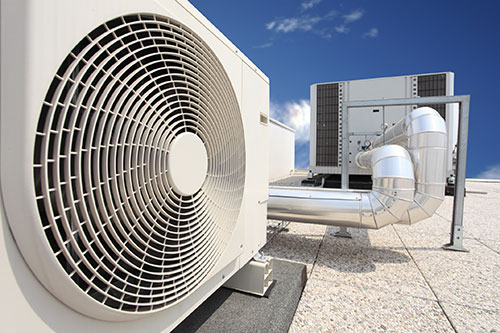In recent times, VRF Systems are considered to be the most improved type of ductless split systems. These systems have been installed successfully for several decades. Let’s get to know more about these systems.
What are VRF (Variable Refrigerant Flow) Systems?
The term VRF “variable refrigerant flow” is an air conditioning system that consists of one outdoor condensing unit and several indoor units. These systems can control the refrigerant amount flowing to different multiple evaporators. VRF systems work on several evaporators that are of different capacities and configurations. Furthermore, they are attached to a single condensing unit.
VRF Systems are equipped with some latest attributes such as variable speed compressors, inverter-driven fans, and last but not least simultaneous heating and cooling through their indoor units. The primary type of VRF System use an outside condenser unit. It is used for providing both heating or cooling. Furthermore, VRF Systems consists of two refrigerant lines, one of them is for supplying, and the other one is for return. Besides, this refrigerant is meant to go through various indoor fan-coils.
Generally, VRF Systems are known for their energy efficiency and a great return on your investments. One can think of VRF systems as a large-scale ductless HVAC system that comes with the capability to work at higher ranges. The design of these systems is also based on their application. Opting for VRF Systems will provide you with state-of-the-art HVAC solution for yourself.
Interestingly, there are several types of VRF systems. Are you eager to know what they are? Here, we bring you a blog on different types of VRF Systems.
Generally, there are four types of VRF systems, such as the 2 pipe VRF system, 3 pipe VRF system, Water-cooling system, and Gas operated system.
Types Of VRF Systems
Heat Pump Systems (2-pipe System)
VRF heat pump systems are also known as 2 pipe VRF system. These systems provide heating and cooling to all the indoor units through the refrigerant pipes, but are insufficient to provide simultaneous heating and cooling function. Here, the indoor units function as evaporators when operating in cooling mode. Vice-versa, the indoor units function as condensers when operating in heating mode.
2 pipe VRF system can provide simultaneous heating and cooling, only when there is a branch controller. This branch controller is placed between the condenser and copper branch piping network that works on delivering the refrigerant to the indoor fan-coil units. One should only opt for a branch controller when there is a possibility of expansion in the coming future.
2 pipe VRF system provides cooling to the areas that need it by supplying the refrigerant through refrigerant pipes in a liquid form. In contrast, the areas that require heating are provided with the refrigerant through refrigerant pipes in a gaseous form.
Furthermore, the extracted heat from cooled areas is then diverted through refnet joints towards heated areas. Here, the condenser work towards providing output difference, which is utterly essential for maintaining the balance of heating and cooling.
Heat Recovery Systems (3 pipe System)
VRF heat recovery systems have the function of providing simultaneous heating and cooling function. The excess heat that could be wasted in traditional heat pump systems is utilized in these systems. The 3 pipe VRF system work on three lines that are attached to the condenser unit.
These three lines consist of: one is for cooling purpose, one for heating purpose, and the last one is a return line. Here, each of the indoor units is diverged using 3 pipes with the use of a solenoid box that is enriched with a set of valves.
The 3 pipe VRF system works on the principles as follows:
VRF heat recovery systems ditch the branch controllers for delivering liquid or gaseous refrigerant through VRF refrigerant piping as this function is already present in the outdoor condenser unit.
Here, the three lines are attached to each indoor fan-coils, and furthermore, each of the units has a branch selector that works on diverting the supply based on the specific operating modes – either heating or cooling.
No matter what is the operating mode, the return is the same for each fan coil.
Water-cooling systems
One of the most commonly used VRF systems are air-cooled systems. These systems make use of the packaged outdoor condensing units through copper branch piping, which is connected to several indoor units.
Water-cooling systems work as an air-cooled unit. These systems use and plate the heat exchanger that, in result, transfers the energy into the water loop instead of opting for a built-in air-cooled heat exchanger.
These systems are attached to a cooling tower or a dry cooler that transfers the heat or energy into the atmosphere. Because of such operation, the water-cooling systems can be deployed internally in smaller areas without any stress regarding the vertical risers. They are also ideal according to the environmental needs.
Gas operated systems
Due to the scarcity of electricity supply, there has been an introduction of Gas operated systems. These systems are enriched with Gas driven engines that work on natural gases or Calor Gas supply. These systems are capable enough to build upto 90 KW of heating and cooling with the use of one single phase.
Interestingly, they are single-phase units and are also enhanced with several advantages such as electrical generation, hot water generation, last but not least, the supply of heat during the defrosting periods.
Wrapping Up
We hope this blog on types of VRF systems will give you an idea regarding which of these systems will be apt for your home or workspace. Each of these systems are unique in their own way, but its you who has to decide the one that suits your needs the best. If you’re still confused, you can also consider asking your near VRF system dealer and choose the one.
Is there any point missing? If yes, Feel free to share in the comments. Also, share your feedback and suggestions in the comments.


